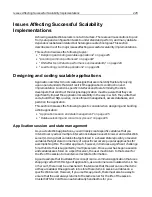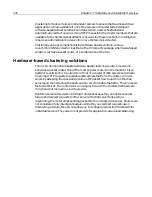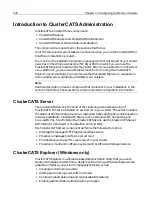
232
Chapter 11 Scalability and Availability Overview
How to load test your Web applications
One of the first things you need to do to be able to load test is purchase a load testing
software tool and learn how to use it.
There are a variety of good load testing software tools on the market, including
Segue’s SilkPerformer, Mercury Interactive’s LoadRunner and RSW’s e-LOAD. Each of
these packages provide substantial Web-enabled software testing solutions that will
help you effectively simulate and test load.
After you purchase, install, and learn to use the load testing software, you need to
determine benchmarks that you want to or must achieve for your Web site to ensure
a good user experience. Following that, you must formalize your testing strategy by
designing and developing written test plans against which you’ll execute your tests.
Once your test plans are written and approved, it’s time to run the tests. After you do
so, you need to capture and analyze the load testing results and report the statistics
to the development team. From there, you’ll need to reach consensus about what are
the most serious problems you discovered, what are the necessary changes to make,
and what is the best way to implement the fixes. After the changes are made and a
new build of the application is available, you’ll rerun the tests to look for
performance improvements. Again, you’ll reanalyze the testing results and continue
this cycle until the site is operating within the established parameters that you’ve set.
When your team agrees that the site scales well and is operating at peak performance
under heavy stress, you’re ready to deploy the application into a production
environment.
Load testing considerations
Before starting your load testing, consider the following:
•
Define benchmarks early
Make sure you understand your Web site’s performance and scalability
requirements before you start running tests against your site. Otherwise, you
won’t know what you’re testing for and the statistics you capture won’t have
significance. Also, remember that the benchmarks you define should be
customized for the current application; don’t simply reuse benchmarks from an
earlier site on which you may have worked. Each Web application is often distinct
in terms of its design, construction, back office integration, and user experience
requirements.
•
Ensure the test environment mirrors the production environment
Create a test environment that is identical as much as possible to the actual
production environment in which the Web site will be hosted. If you don’t
simulate a similar network and bandwidth scenario, or use the same types of
servers, or ensure that the same versions of software (operating system, service
packs, Web server, and third-party tools) reside on both the test and production
servers, you can’t anticipate problems nor determine why they occur. The
number of possibilities would be too large.
Summary of Contents for COLDFUSION 5-ADVANCED ADMINISTRATION
Page 1: ...Macromedia Incorporated Advanced ColdFusion Administration ColdFusion 5...
Page 20: ......
Page 56: ...38 Chapter 1 Advanced Data Source Management...
Page 74: ...56 Chapter 2 Administrator Tools...
Page 76: ......
Page 86: ...68 Chapter 3 ColdFusion Security...
Page 87: ...To Learn More About Security 69...
Page 88: ...70 Chapter 3 ColdFusion Security...
Page 130: ...112 Chapter 5 Configuring Advanced Security...
Page 132: ......
Page 154: ...136 Chapter 6 Configuring Verity K2 Server...
Page 162: ...144 Chapter 7 Indexing XML Documents...
Page 202: ...184 Chapter 8 Verity Spider...
Page 236: ...218 Chapter 10 Verity Troubleshooting Utilities...
Page 238: ......
Page 348: ...330 Chapter 14 ClusterCATS Utilities...
Page 349: ...Using sniff 331...
Page 350: ...332 Chapter 14 ClusterCATS Utilities...
Page 362: ...344 Chapter 15 Optimizing ClusterCATS...
Page 372: ...354 Index...
















































